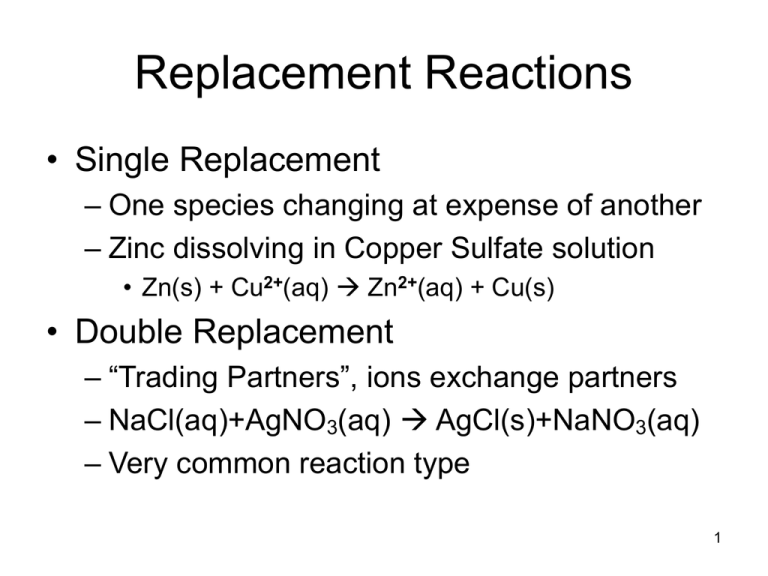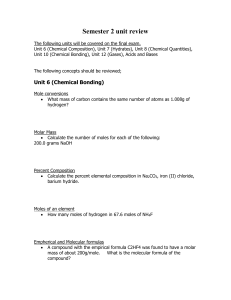Chem32a_Stoich2__mini_26oct10
advertisement

Replacement Reactions • Single Replacement – One species changing at expense of another – Zinc dissolving in Copper Sulfate solution • Zn(s) + Cu2+(aq) Zn2+(aq) + Cu(s) • Double Replacement – “Trading Partners”, ions exchange partners – NaCl(aq)+AgNO3(aq) AgCl(s)+NaNO3(aq) – Very common reaction type 1 Why does replacement occur? • Formation of gas or solid – Removes materials from solution, • 1-way street, removed material no longer available • Chemical activity – Some materials more reactive than others • Alkalai metals dissolve in water to make hydrogen • Gold, Silver, Copper found as elements in nature – We make an empirical list of reactivity • Hydrogen chosen as reference point • Metals MORE active than hydrogen dissolve in water • Metals LESS active than hydrogen don’t dissolve in water 2 Activity Series of Elements • Oxidation rates differ greatly – Sodium reacts instantly & violently (Potassium more so) • With water or any oxidizer (e.g. O2, Cl2) – Iron rusts slowly but surely, no metallic iron in nature • >100 year old steel structures, autos, tools – Gold does not oxidize at all • Native gold here after 4.5*10^9 years (age of earth) • Artifacts found >1,000 years old • “Activity” is qualitative oxidation measure – Activity Series = relative reactivity • Voltage is quantitative oxidation measure – Half Cells, referenced to Hydrogen 3 • Chemical Activity – Elements are different • High to low activity – Index is acid reaction • Is hydrogen liberated? – “Active” elements • Liberate H2 with acid • Replace less reactive – Transition = hydrogen • Reference Activity point – “Less Active” elements • No acid reactions • Replace less reactive – A Qualitative concept • No measured values 4 Activity Series of Elements • Element higher in chart will replace the ones below – Iron replaces (reduces) Copper ion • Fe0 + Cu++ Fe ++ + Cu0 • Iron is oxidized, Copper gets reduced • Hydrogen defined as reference point – Elements above Hydrogen can liberate H2 gas • Zn0 + 2H+ (acid ion) Zn++ + H2(g) • Half Cells, referenced to Hydrogen • Elements below Hydrogen don’t liberate H2 gas – No reaction with (non-oxidizing) acids 5 Copper replacing Silver more active copper dissolves, less active silver precipitates, a SINGLE REPLACEMENT reaction, also an example of a REDOX reaction 6 Single Replacement Examples 7 Double Replacement Examples • Na2SO4(aq) + BaCl2(aq) BaSO4(s) + 2NaCl(aq) – Barium Sulfate very insoluble, swallow for X-ray imaging • AgNO3(aq) + NaBr(aq) AgBr(s) + NaNO3(aq) – Silver Bromide very insoluble but light sensitive, photo film • HCl(aq) + NaOH(aq) NaCl(aq) + HOH + heat – Neutralization of acid + base creates water & heat 8 Four Reaction Types 9 Limiting Reactants • Nature rarely provides 100% balance – Oxygen in air exceeds animal and fuel needs – Almost always an excess of all but 1 reactant – One which runs out first = “Limiting” reactant – Even with perfect balance of reactants • Reaction may not end in timely fashion (or ever) 10 Social analogy • Limiting reactants can be people, not chemicals – Male/Female birth ratio starts out ≈ 50/50% • Chinese government limits Number of children – Boy babies favored over girls, preserve family name – Intervention result is surplus of males over females • Implication is more bachelor men without families • Women are the limiting reagent, all girls have husbands, • Run out of women first, men are in surplus • Warfare effects mostly men – Mostly males volunteer (or are drafted) as soldiers – Soldiers kill each other, reducing male population – Result is surplus of females over males after war • Implication is more women without men • Men are the limiting reagent, all men have wives, • Run out of men first, women are in surplus 11 Hindenburg Hydrogen Explosion Atmosphere 21% oxygen, Limited reactant was hydrogen, 12 Stoichiometry Conversions 13 Mole relationships 14 Balancing Equations • Same atoms before & after rearrangement – Mass not created or destroyed in reactions – Need to find correct multipliers (coefficients) – Reactants and products must be realistic • Trading atomic partners is common – AgNO3 + KCl AgCl(s) + KNO3 – Parenthesis (s) indicates solid precipitate – Precipitates takes reactants out of solution, typically makes reaction irreversible 15 Chemical Equation Balancing • Start with the elements which are changing form – Often the metals or carbon – Write the unbalanced input + output materials • (unbalanced) Na0(s) + H2O NaOH(aq) + H2 (g) – Make sure same number of metal atoms both sides • (1) Na0 (1) Na+ • This atomic ratio must remain constant (in = out) – Oxygen and Hydrogen are balanced last • Not enough hydrogen on right side with only 1 water • Need to double other materials for hydrogen to balance • (balanced) 2Na0(s)+2H2O 2NaOH(aq) + H2 (g) 16 Quantitative Relationships • Coefficients in a reaction = quantity • Reactions occur in Mole multiples – Moles are key reaction quantities – Mass to moles of reactants – Reaction product back to mass if need be • Percent Yield – Actual / theoretical = yield • Limiting Reactants – One reactant (almost) always in surplus 17 Sequence of events • Convert mass to moles (or molecules) – Cannot balance an equation with grams – Atoms weigh different amounts • Balance equation of reactants + products – Mass Balance + Charge Balance – Ratio multipliers refer to moles or molecules • Convert moles back to mass – Answers often desired in grams – We weigh in grams, calculate in moles 18 Example #1 • Glass powder is reacted with 727kg of impure charcoal which is 88.9% carbon. How much SiC is produced? – Get grams into moles, – consider reaction based on moles – Convert product moles back to grams • SiO2(s) + 3 C(s) SiC(s) + 2 CO(g) – – – – – Amount of pure carbon 0.889*727kg = 646kg 646kg C / 12.01 g/mol = 53,790 moles Carbon Reaction ratio is 1/3 mole SiC per mole Carbon Moles of SiC = 53,790 / 3 = 17,930 moles SiC 17,930 moles SiC * 40.1gm/mole = 719 kg SiC 19 Thermite in action, another classic single replacement reaction 20 How to obtain molten iron! Mix powdered aluminum and iron oxide (rust), then ignite Applications include welding railroad tracks, military sabotage 21 Example #2 • Thermite is a mixture of iron oxide and aluminum powder, when ignited produces liquid iron and aluminum oxide. • Fe2O3(s) + 2 Al(s) 2 Fe(s) + Al2O3(s) + heat • How much aluminum to mix with a pound of iron oxide?, and how much iron is produced? – Get pounds of iron oxide into grams, then into moles, – consider reaction based on moles – Convert desired moles back to grams 22 Example #2 • Fe2O3(s) + 2 Al(s) 2 Fe(s) + Al2O3(s) + heat • Amount of iron oxide involved? – – – – – Starting with 1 pound = 454 gm of iron oxide 454 gm iron oxide / 159.7 g/mol = 2.84 moles Fe2O3 Reaction ratio is 2 mole of Al per mole Fe2O3 2.84 mole Fe2O3 * 2 (Al/Fe2O3) = 5.69 Moles of Al 5.69 mol Al needed * 26.98 gm/mol = 153.4 gm Al • Amount of iron produced ? – 2.84 mole Fe2O3 * 2 (Fe/Fe2O3) = 5.69 Moles of Fe – 5.69 moles Fe * 55.85 gm/mol = 317.5 gm Fe 23 Now to today’s experiment • More work with Stoichiometry – Key to quantitative measurements – Handout due next week • S’mores analogy – Use everyday edibles as “elements” • C=Chocolate, G=graham cracker, M=marshmallow – Combine elements into a “compound” • Sm = S’mores compound (a sandwich) • C + 2G + M CG2M – Determine reaction limitations • When some materials used up, reaction stops • Calculate leftovers – OK to eat the experiment • Clean lab surfaces well before handling food • Also due next week 24 What’s a S’more ? Girl Scout camping-out invention from 1927 Graham Crackers + chocolate + marshmallow 25 Traditional Campfire Method • • • • • • Place chocolate bar on graham cracker Heat up the marshmallow over open fire Put hot marshmallow over chocolate Put another cracker on top Squeeze together, insides melt together Eat it 26 Campfire Cuisine Toasted marshmallow melts the chocolate Graham crackers top & bottom form a sandwich, makes it easier to handle the hot materials 27 Laboratory Method • Start with fixed amounts of “elements” • Weigh each component – Weigh more than 1, take an average • Assemble S’mores “compound” – Weigh the compound – Demonstrates conservation of mass, in = out – Demonstrates Dalton’s law of simple multiples • Have some fun – Bunsen Burner is our “campfire” – Does heating change the “compound” ? 28 Experiment • Lets do it 29





